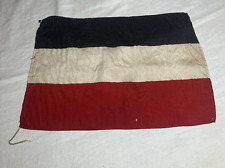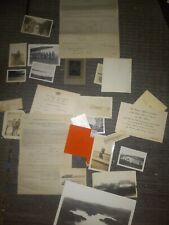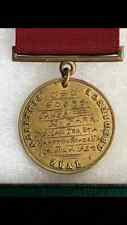When you click on links to various merchants on this site and make a purchase, this can result in this site earning a commission. Affiliate programs and affiliations include, but are not limited to, the eBay Partner Network.
PLEASE FOLLOW OUR E BAY STORESEE ALL PICSSALE SEE OUR STOREPLEASE READ WHOLE ADD
PLEASE SEE STORELOT MORE --COMBINE SHIPPINGSAVE $$$$$$$$$$$$$$$Inter-war entrenchment and expansion (1918–1941)[edit]Further information:Washington Naval Conference,London Naval Treaty, andUSS Panay incident
At the end of World War I, the United States Navy had almost 500,000 officers and enlisted men and women and in terms of personnel was the largest in the world.[3]Younger officers were enthusiastic about the potential of land-based naval aviation as well as the potential roles of aircraft carriers. Chief of Naval Operations Benson was not among them. He tried to abolish aviation in 1919 because he could not "conceive of any use the fleet will ever have for aviation." However Roosevelt listened to the visionaries and reversed Benson's decision.[115]
USSLangley, the US Navy's first aircraft carrier.
After a short period of demobilization, the major naval nations of the globe began programmes for increasing the size and number of their capital ships. Wilson's plan for a world-leading set of capital ships led to a Japanese counter-programme, and a plan by the British to build sufficient ships to maintain a navy superior to either. American isolationist feeling and the economic concerns of the others led to theWashington Naval Conferenceof 1921. The outcome of the conference included theWashington Naval Treaty(also known as the Five-Power treaty), and limitations on the use of submarines. The Treaty prescribed a ratio of 5:5:3:1:1 for capital ships between treaty nations. The treaty recognized the U.S. Navy as being equal to the Royal Navy with 525,000 tons of capital ships and 135,000 tons of aircraft carriers, and the Japanese as the third power. Many older ships were scrapped by the five nations to meet the treaty limitations, and new building of capital ships limited.[116]
One consequence was to encourage the development oflight cruisersandaircraft carriers. The United States's first carrier, a convertedcolliernamedUSSLangleywas commissioned in 1922, and soon joined byUSSLexingtonandUSSSaratoga, which had been designed asbattlecruisersuntil the treaty forbade it. Organizationally, theBureau of Aeronauticswas formed in 1921; naval aviators would become referred to as members of theUnited States Naval Air Corps.[117]
Army airmanBilly Mitchellchallenged the Navy by trying to demonstrate that warships could be destroyed by land-based bombers. He destroyed his career in 1925 by publicly attacking senior leaders in the Army and Navy for incompetence for their "almost treasonable administration of the national defense."[118]
Chief of Naval OperationsWilliam V. Pratt(1930-1933) agreed withPresident Hoovers'semphasis on disarmament and went along with postponement of new construction and cutting the fleet. Other naval officers disagreed sharply with Hoover's policies.[119][120]
President Franklin Roosevelt (1933-1945)had been in effect in civilian control of the Navy during World War I, knew many senior officers, and strongly supported naval expansion.[121]TheVinson-Trammell Actof 1934 set up a regular program of ship building and modernization to bring the Navy to the maximum size allowed by treaty. The Navy's preparation was helped along by another Navy assistant secretary turned president, Franklin D. Roosevelt.[122]The naval limitation treaties also applied to bases, but Congress only approved building seaplane bases onWake Island,Midway IslandandDutch Harborand rejected any additional funds for bases on Guam and the Philippines.[123]Navy ships were designed with greater endurance and range which allowed them to operate further from bases and between refits.[124]
USSNorth Carolina
The Navy had a presence in the Far East with a naval base in the US-owned Philippines and river gunboats in China on theYangtze River. The gunboatUSSPanaywas bombed and machine-gunned by Japanese airplanes. Washington quickly accepted Japan's apologies and compensation.
African-Americans were enlisted during World War I, but this was halted in 1919 and they were mustered out of the Navy. Starting in the 1930s a few were recruited to serve as stewards in the officers mess. African-Americans were recruited in larger numbers only after Roosevelt insisted in 1942.[125]
TheNaval Act of 1936authorized the first new battleship since 1921, andUSSNorth Carolina, was laid down in October 1937. TheSecond Vinson Actauthorized a 20% increase in the size of the Navy, and in June 1940 theTwo-Ocean Navy Actauthorized an 11% expansion in the Navy.Chief of Naval OperationsHarold Rainsford Starkasked for another 70% increase, amounting to about 200 additional ships, which was authorized by Congress in less than a month. In September 1940, theDestroyers for Bases Agreementgave Britain much-needed destroyers—of WWI vintage—in exchange for United States use of British bases.[126]
In 1941, theAtlantic Fleetwas reactivated. The Navy's first shot in anger came on April 9, when the destroyerUSSNiblackdropped depth charges on a U-boat detected whileNiblackwas rescuing survivors from a torpedoed Dutch freighter. In October, the destroyersKearnyandReuben Jameswere torpedoed, andReuben Jameswas in Hawaii in 1943
Submarines were the "silent service"—in terms of operating characteristics and the closed-mouth preferences of the submariners. Strategists had, however, been looking into this new type of warship, influenced in large part by Germany's nearly successful U-boat campaign. As early as 1912, Lieutenant Chester Nimitz had argued for long-range submarines to accompany the fleet to scout the enemy's location. The new head of the Submarine Section in 1919 was Captain Thomas Hart, who argued that submarines could win the next war: "There is no quicker or more effective method of defeating Japan than the cutting of her sea communications."[128]However Hart was astonished to discover how backward American submarines were compared to captured German U-boats, and how unready they were for their mission.[129]
The public supported submarines for their coastal protection mission; they would presumably intercept enemy fleets approaching San Francisco or New York. The Navy realized it was a mission that isolationists in Congress would fund, but it was not actually serious. Old-line admirals said the mission of the subs ought to be as eyes of the battle fleet, and as assistants in battle. That was unfeasible since even on the surface submarines could not move faster than 20 knots, far slower than the 30 knot main warships. The young commanders were organized into a "Submarine Officers' Conference" in 1926.[130]They argued they were best suited for the commerce raiding that had been the forte of the U-boats. They therefore redesigned their new boats along German lines, and added the new requirement that they be capable of sailing alone for 7,500 miles on a 75-day mission. Unrestricted submarine warfare had led to war with Germany in 1917, and was still vigorously condemned both by public opinion and by treaties, including the London Treaty of 1930. Nevertheless, the submariners planned a role in unrestricted warfare against Japanese merchant ships, transports and oil tankers. The Navy kept its plans secret from civilians. It was an admiral, not President Roosevelt, who within hours of the Pearl Harbor attack, ordered unrestricted warfare against any enemy ship anywhere in the Pacific.[131]
The submariners had won over Navy strategists, but their equipment was not yet capable of handling their secret mission. The challenge of designing appropriate new boats became a high priority by 1934, and was solved in 1936 as the first new long-range, all welded submarines were launched. Even better were the S-classSalmonclass(launched in 1937), and its successors the T-class orTamborsubmarinesof 1939 and theGatoclass of 1940. The new models cost about $5–6 million each. At 300 feet in length and 1500 tons, they were twice as big as the German U-boats, but still highly maneuverable. In only 35 seconds they could crash dive to 60 feet. The superb Mark 3 TDC Torpedo Data Computer (an analog computer) took data from periscope or sonar readings on the target's bearing, range and angle on the bow, and continuously set the course and proper gyroscope angle for a salvo of torpedoes until the moment of firing. Six forward tubes and 4 aft were ready for the 24 Mk-14 "fish" the subs carried. Cruising on the surface at 20 knots (using 4 diesel engines) or maneuvering underwater at 8-10 knots (using battery-powered electric motors) they could circle around slow-moving merchant ships. New steels and welding techniques strengthened the hull, enabling the subs to dive as deep as 400 feet in order to avoid depth charges. Expecting long cruises the 65 crewmen enjoyed good living conditions, complete with frozen steaks and air conditioning to handle the hot waters of the Pacific. The new subs could remain at sea for 75 days, and cover 10,000 miles, without resupply. The submariners thought they were ready—but they had two hidden flaws. The penny-pinching atmosphere of the 1930s produced hypercautious commanders and defective torpedoes. Both would have to be replaced in World War II.[







